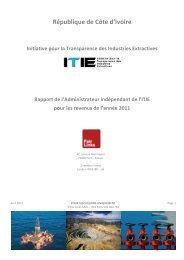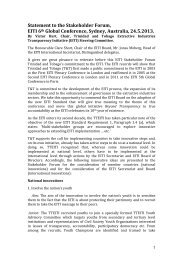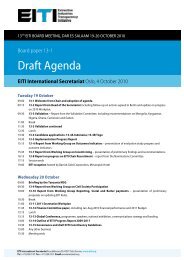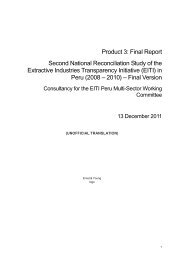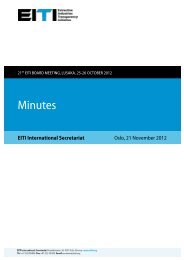Vietnam feasibility study - EITI
Vietnam feasibility study - EITI
Vietnam feasibility study - EITI
Create successful ePaper yourself
Turn your PDF publications into a flip-book with our unique Google optimized e-Paper software.
cHaPTer Iv<br />
TransParencY reGulaTIOns In vIeTnam<br />
Iv.1 - DefInITIOn Of TransParencY<br />
Transparency is considered as the principle<br />
and goal of governance. The most obvious and<br />
robust effects of transparency can be seen on<br />
the economy, governance and politics (Oliver,<br />
2004). Some studies suggest that transparency<br />
is a Western concept. However, this concept<br />
has a longer history and broader application<br />
that does is not limited to a single race, faith or<br />
nation. At the present, transparency can also<br />
generate a competitive economic advantage<br />
for a country or business.<br />
Characteristic of governments, companies,<br />
organisations and individuals of being open<br />
in the clear disclosure of information, rules,<br />
plans, processes and actions. As a principle,<br />
public officials, civil servants, the managers<br />
and directors of companies and organisations,<br />
and board trustees have a duty to act visibly,<br />
predictably and understandably to promote<br />
participation and accountability.<br />
(Transparency International, 2009)<br />
Transparency in international organizations refers to the ability to access accurate information by the<br />
public. For example, the WTO claims that international trade agreements must ensure three elements<br />
to be transparent: information on laws, regulations or policies are widely publicized; all changes in<br />
laws, regulations or policy are publicly announced; laws and regulations are consistently and equally<br />
implemented through appropriate methods. According to the Multilateral Investment Agreement<br />
(MIA), to ensure transparency, each country must publicize its’ legal regulations, related procedures<br />
or administrative regulations that may effect on an agreement. OECD (2002) describes a transparent<br />
business environment as an environment where economic agents have necessary information and<br />
there is no asymmetric or hidden information. Transparency is considered as the result of two-way<br />
exchanges of information between government and partners.<br />
Many recent studies show that transparency not only mentions the quantity of information, but also<br />
the content, scope, accuracy and timeliness of information that economic agents (people, business<br />
or government) can access (Vishwanath & Kaufmann, 1999; Kaufmann & Kraay, 2002; Islam, 2003).<br />
The Extractive Industries Transparency Initiative and the Implementation Perspective of <strong>Vietnam</strong><br />
45







